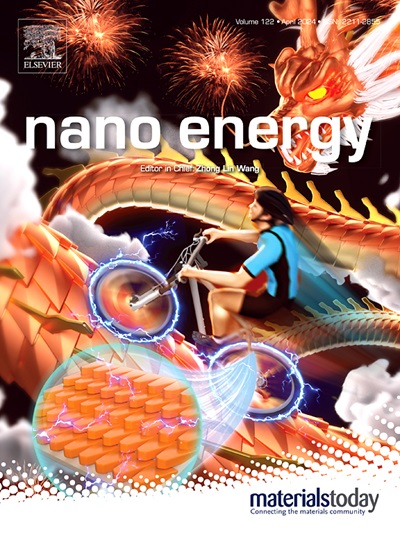Phytic Acid-Decorated Ag/NiCo Layered Double Hydroxide for Highly Active and Durable Anion Exchange Membrane Water Electrolyzer
IF 16.8
1区 材料科学
Q1 CHEMISTRY, PHYSICAL
引用次数: 0
Abstract
Anion exchange membrane water electrolyzer (AEMWE) represents the cleanest and most cost-competitive pathway to generate hydrogen with zero carbon emission. However, the poor activity and durability of oxygen evolution reaction (OER) electrocatalyst in the anode result in the low performance of AEMWE. In this study, we design an electrocatalyst comprising silver nanoparticles anchored in phytic acid-decorated NiCo layered double hydroxide (Ag/NiCo LDH-PA) to address this limitation. The AEMWE equipped with Ag/NiCo LDH-PA anode achieves 1 A cm-2 and 5 A cm-2 at ultralow potentials of 1.65 V and 2.04 V, respectively. Additionally, it operates continuously at an industrial current density of 1 A cm-2 for 650 hours. Experimental and theoretical studies reveal that the generated oxygen vacancies and surface-absorbed phosphate ions from phytic acid could efficiently stabilize active sites and reduce the energy barriers of reaction, thereby enhancing the OER performance. These results highlight the importance of surface modification in LDH materials for highly active and durable electrocatalyst development and accelerate the broad deployment of AEMWE.

植酸修饰Ag/NiCo层状双氢氧化物用于高活性耐用阴离子交换膜电解器
阴离子交换膜水电解槽(AEMWE)代表了最清洁和最具成本竞争力的零碳排放制氢途径。然而,阳极析氧反应(OER)电催化剂的活性和耐久性较差,导致AEMWE性能较低。在这项研究中,我们设计了一种电催化剂,其中包含银纳米颗粒,锚定在植酸修饰的NiCo层状双氢氧化物(Ag/NiCo LDH-PA)中,以解决这一限制。采用Ag/NiCo LDH-PA阳极的AEMWE在1.65 V和2.04 V的超低电位下分别达到1 A cm-2和5 A cm-2。此外,它可以在1 A cm-2的工业电流密度下连续工作650小时。实验和理论研究表明,植酸生成的氧空位和表面吸附的磷酸盐离子可以有效地稳定活性位点,降低反应的能垒,从而提高OER性能。这些结果强调了LDH材料表面改性对于高活性和耐用电催化剂开发的重要性,并加速了AEMWE的广泛应用。
本文章由计算机程序翻译,如有差异,请以英文原文为准。
求助全文
约1分钟内获得全文
求助全文
来源期刊

Nano Energy
CHEMISTRY, PHYSICAL-NANOSCIENCE & NANOTECHNOLOGY
CiteScore
30.30
自引率
7.40%
发文量
1207
审稿时长
23 days
期刊介绍:
Nano Energy is a multidisciplinary, rapid-publication forum of original peer-reviewed contributions on the science and engineering of nanomaterials and nanodevices used in all forms of energy harvesting, conversion, storage, utilization and policy. Through its mixture of articles, reviews, communications, research news, and information on key developments, Nano Energy provides a comprehensive coverage of this exciting and dynamic field which joins nanoscience and nanotechnology with energy science. The journal is relevant to all those who are interested in nanomaterials solutions to the energy problem.
Nano Energy publishes original experimental and theoretical research on all aspects of energy-related research which utilizes nanomaterials and nanotechnology. Manuscripts of four types are considered: review articles which inform readers of the latest research and advances in energy science; rapid communications which feature exciting research breakthroughs in the field; full-length articles which report comprehensive research developments; and news and opinions which comment on topical issues or express views on the developments in related fields.
 求助内容:
求助内容: 应助结果提醒方式:
应助结果提醒方式:


